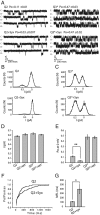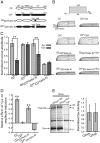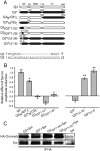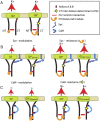Regulation of neuronal M-channel gating in an isoform-specific manner: functional interplay between calmodulin and syntaxin 1A
- PMID: 21976501
- PMCID: PMC6623657
- DOI: 10.1523/JNEUROSCI.2666-11.2011
Regulation of neuronal M-channel gating in an isoform-specific manner: functional interplay between calmodulin and syntaxin 1A
Abstract
Whereas neuronal M-type K(+) channels composed of KCNQ2 and KCNQ3 subunits regulate firing properties of neurons, presynaptic KCNQ2 subunits were demonstrated to regulate neurotransmitter release by directly influencing presynaptic function. Two interaction partners of M-channels, syntaxin 1A and calmodulin, are known to act presynaptically, syntaxin serving as a major protein component of the membrane fusion machinery and calmodulin serving as regulator of several processes related to neurotransmitter release. Notably, both partners specifically modulate KCNQ2 but not KCNQ3 subunits, suggesting selective presynaptic targeting to directly regulate exocytosis without interference in neuronal firing properties. Here, having first demonstrated in Xenopus oocytes, using analysis of single-channel biophysics, that both modulators downregulate the open probability of KCNQ2 but not KCNQ3 homomers, we sought to resolve the channel structural determinants that confer the isoform-specific gating downregulation and to get insights into the molecular events underlying this mechanism. We show, using optical, biochemical, electrophysiological, and molecular biology analyses, the existence of constitutive interactions between the N and C termini in homomeric KCNQ2 and KCNQ3 channels in living cells. Furthermore, rearrangement in the relative orientation of the KCNQ2 termini that accompanies reduction in single-channel open probability is induced by both regulators, strongly suggesting that closer N-C termini proximity underlies gating downregulation. Different structural determinants, identified at the N and C termini of KCNQ3, prevent the effects by syntaxin 1A and calmodulin, respectively. Moreover, we show that the syntaxin 1A and calmodulin effects can be additive or blocked at different concentration ranges of calmodulin, bearing physiological significance with regard to presynaptic exocytosis.
Figures









Similar articles
-
Structural determinants of M-type KCNQ (Kv7) K+ channel assembly.J Neurosci. 2006 Apr 5;26(14):3757-66. doi: 10.1523/JNEUROSCI.5017-05.2006. J Neurosci. 2006. PMID: 16597729 Free PMC article.
-
Regulation of the neuronal KCNQ2 channel by Src--a dual rearrangement of the cytosolic termini underlies bidirectional regulation of gating.J Cell Sci. 2015 Sep 15;128(18):3489-501. doi: 10.1242/jcs.173922. Epub 2015 Aug 14. J Cell Sci. 2015. PMID: 26275828
-
Selective interaction of syntaxin 1A with KCNQ2: possible implications for specific modulation of presynaptic activity.PLoS One. 2009 Aug 13;4(8):e6586. doi: 10.1371/journal.pone.0006586. PLoS One. 2009. PMID: 19675672 Free PMC article.
-
SNAREing voltage-gated K+ and ATP-sensitive K+ channels: tuning beta-cell excitability with syntaxin-1A and other exocytotic proteins.Endocr Rev. 2007 Oct;28(6):653-63. doi: 10.1210/er.2007-0010. Epub 2007 Sep 18. Endocr Rev. 2007. PMID: 17878408 Review.
-
Flexible Stoichiometry: Implications for KCNQ2- and KCNQ3-Associated Neurodevelopmental Disorders.Dev Neurosci. 2021;43(3-4):191-200. doi: 10.1159/000515495. Epub 2021 Apr 1. Dev Neurosci. 2021. PMID: 33794528 Free PMC article. Review.
Cited by
-
Cooperative endocytosis of the endosomal SNARE protein syntaxin-8 and the potassium channel TASK-1.Mol Biol Cell. 2014 Jun 15;25(12):1877-91. doi: 10.1091/mbc.E13-10-0592. Epub 2014 Apr 17. Mol Biol Cell. 2014. PMID: 24743596 Free PMC article.
-
Raised Intracellular Calcium Contributes to Ischemia-Induced Depression of Evoked Synaptic Transmission.PLoS One. 2016 Mar 2;11(3):e0148110. doi: 10.1371/journal.pone.0148110. eCollection 2016. PLoS One. 2016. PMID: 26934214 Free PMC article.
-
Kv7 Channels and Excitability Disorders.Handb Exp Pharmacol. 2021;267:185-230. doi: 10.1007/164_2021_457. Handb Exp Pharmacol. 2021. PMID: 33860384
-
Structural insights into neuronal K+ channel-calmodulin complexes.Proc Natl Acad Sci U S A. 2012 Aug 21;109(34):13579-83. doi: 10.1073/pnas.1207606109. Epub 2012 Aug 6. Proc Natl Acad Sci U S A. 2012. PMID: 22869708 Free PMC article.
-
Phosphoproteome Analysis Identifies a Synaptotagmin-1-Associated Complex Involved in Ischemic Neuron Injury.Mol Cell Proteomics. 2022 May;21(5):100222. doi: 10.1016/j.mcpro.2022.100222. Epub 2022 Mar 5. Mol Cell Proteomics. 2022. PMID: 35257887 Free PMC article.
References
-
- Biervert C, Schroeder BC, Kubisch C, Berkovic SF, Propping P, Jentsch TJ, Steinlein OK. A potassium channel mutation in neonatal human epilepsy. Science. 1998;279:403–406. - PubMed
-
- Bofill-Cardona E, Kudlacek O, Yang Q, Ahorn H, Freissmuth M, Nanoff C. Binding of calmodulin to the D2-dopamine receptor reduces receptor signaling by arresting the G protein activation switch. J Biol Chem. 2000;275:32672–32680. - PubMed
-
- Bright JN, Sansom MSP. The flexing/twirling helix: exploring the flexibility about molecular hinges formed by praline and glycine motifs in transmembrane helices. J Phys Chem B. 2003;107:627–636.
-
- Brown DA, Adams PR. Muscarinic suppression of a novel voltage-sensitive K+ current in a vertebrate neurone. Nature. 1980;283:673–676. - PubMed
Publication types
MeSH terms
Substances
LinkOut - more resources
Full Text Sources
Other Literature Sources
